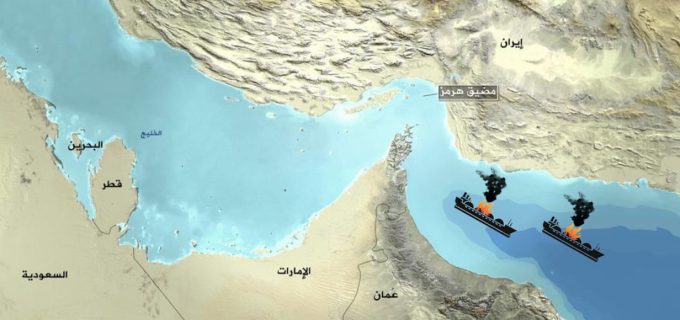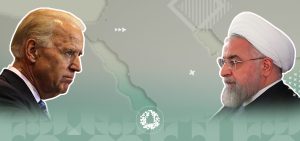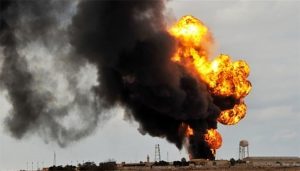On 13 June, two international oil tankers heading to East Asia were attacked in the Sea of Oman. Washington accused Tehran of the attack. However, the latter has denied any responsibility for the attack and accused other parties of seeking to fuel the crisis between Iran and Washington.
This attack has had ripple effects, especially on the economy, increasing Brent crude by more than 2%, while US crude reached 1.5% immediately after the attack.
In the same vein, the crisis between the US and Iran is still ongoing ever since President Donald Trump announced the US withdrawal from the nuclear agreement in May 2018, and the subsequent sanctions imposed on Iran had a direct impact on the economy. Iran also threatened that it will not be the only country to face this crisis; hence the subsequent occurrences of insecurity events close to the Strait of Hormuz, which is one of the most important lines of maritime trade.
Surprisingly, the US president downgraded the importance of the strait to the US, which has become the world’s largest energy producer. He pointed out China and Japan as the most affected and called on them to protect their ships in the strait. This poses a number of questions about the reality of the attacks and their economic dimensions, especially with the US growing ambition to be the leader of the global oil market.
The Economic Importance of the Strait of Hormuz
The Strait of Hormuz constitutes the lungs of the Gulf States. The strait links the Persian Gulf and the Gulf of Oman on one hand and the Arabian Sea and the Indian Ocean on the other, having Iran in the north and in the south the Sultanate of Oman, which monitors maritime navigation as shipping lanes cross its territorial waters.
The strait is 50 km in width, 60 km in-depth and the narrowest part reaches 33 km. The width of the entry and exit corridors is equal to two nautical miles.
According to Reuters reporting oil analyst company Vortex, about one-fifth of the world’s oil production equal to around 17.4 million barrels per day pass through the strait. Meanwhile, consumption amounted to 100 million barrels per day in 2018, most of which were transferred to China, India, Japan, and other Southeast Asian countries. In case of any problem occurring at the strait or its vicinity, the first victim will be those countries, on top of which is China, the US economic rival.
Most of Iran, Saudi Arabia, the United Arab Emirates, Kuwait, and Iraq crude exports pass through the strait, as well as the production of liquefied natural gas (LNG) belonging to the world’s largest exporter of this material, Qatar. Some 22% of the world’s commodities find their way through the strait.
The strait is an international waterway protected by Article 38 of the International Convention on the Law of the Sea Convention, adopted on 30 April 1982, which provides that “all vessels crossing international straits, including the Strait of Hormuz, have the right to unimpeded passage, whether ships or commercial or military carriers”.
This great importance of the strait enabled any security event happening next to it to have a major effect on the economy of the region and the world, for it links the largest oil depot to the world’s largest market.
The US and economic ambition
Ever since the US president decided to withdraw from the nuclear agreement with Iran, tensions between the two countries grew to be more serious. The US is exerting pressure on Iran to accept another agreement, which is more restrictive than the previous, and aiming to impose a number of sanctions on Tehran, whose 40% of the budget depends on oil exports. These sanctions include a ban on oil exports. The US also imposed other sanctions affecting the mining and petrochemical sectors and the Revolutionary Guards, too. Besides, reinforcing the US military presence in the region caused the downturn of the Iranian economy and the level of tension between the US and its regional allies, on the one hand, and the US and Iran, on the other, to increase.
The US has exploited Iranian threats and rushed to hold Tehran responsible for the attacks carried out near the Strait of Hormuz, especially the recent offense targeting the two carriers. US President Donald Trump held Iran responsible, referring to the Iranian boat spotted in a video released by the US military. He claims this boat belongs to the Revolutionary Guards, who were trying to demine one of the two carriers.
Earlier, the US president warned Iran against taking any military action that could be detrimental to the interests of the US or its allies. Thus, the US Defence Department reinforced its military presence in the region, sending Lincoln aircraft carrier along with a fleet of 27 destroyers, battleships, and submarines, as well as four B-52 bombers capable of carrying nuclear weapons. The USS Arlington, designed to transport US marines, was also sent with amphibious vehicles, equipment, combat helicopters, MIM-104 Patriot, and other weapons.
These US presidents’ rapid accusations of Iran and the increasing military build-up in the region indicate the existence of targets related to Iran and others that may have an impact on the future of the region. This explains the analyses indicating the role America has in the bombing, albeit indirectly, so as to engage in a greater crisis with Iran and internationalize the Gulf region to protect the area and as navigation in it. Such tendency is justified by the US’s inability to mobilize international support for its position as regards Iran, being the one responsible for the abolition of the agreement. The US reiterated accusations of Iran were not adopted by any of the signatory States (to the nuclear agreement) with Britain as the sole exception.
Amid the growing tension, the Office of the Minister of Foreign Affairs of the European Union, Federica Mogherini reported that signatories of the agreement (5 + 1) will meet with Iran on 28 June, in the Austrian capital, (Vienna), to find new ways to keep the agreement and save it.
A major dimension connected to these events is related to the US attempt to take advantage of any imbalances involving oil coming from the Gulf, and the marketing of oil as an alternative to turn US into a major exporter and remove Saudi Arabia and Russia from the top list of exporting countries. Especially that the US is producing around 12 million barrels per day, three million of which are being exported every day, and it is seeking to double production in the coming years, and increase exports to 5 million barrels per day. Hence, the US is trying to lead the world oil market, as the US president declared that: “America does not need to be present in the Gulf area and we have become the world’s largest energy producer.”
Washington imposed a set of sanctions on a number of some other countries, including China, and raised tariffs in May by 10% to 25%. The US presidency ordered tariffs to be imposed on other Chinese goods, including all Chinese imports, and China responded by issuing similar decisions. In addition, the US President of the United States asked China to protect its own vessels.
Iran and the buying time battle
Despite its repeated threats, Iran keeps denying any relation with any attack, and believes that this offence was meant to disperse international efforts aiming to contain the situation. Iran is also suggesting that another party wants to raise tensions between it and Washington. The Iranian quest to exert pressure on the global economic market in order to reach a settlement as regard to the US sanctions and engage the international community and China in this process may highlight the interest Iran has in these attacks given the internal and external harassment and economic strangulation the country is being subjected to. Iran has repeatedly stated that if prevented from exporting oil, it will not allow others to do it. Hence, the closure of the The Strait of Hormuz or carrying security attacks in the vicinity can be an explanation for that.
What might prelude Iran’s involvement in the attack on the oil tankers is the visit the Japanese Prime Minister, Shinzō Abe, paid to Iran in order to find a political solution, which coincided with the offence. However, Iran is also unlikely to stand idly by so as not to trigger serious US reaction, and to draw the attention of the international community to the danger that might occur in case these sanctions are persistent, hoping for political change in the US after 2020 presidential elections.
As for the closure of the strait, it may be ruled out for a number of reasons, namely:
- US military build-up in the Gulf of Oman to protect oil export.
- Closure of the strait will be at the root of an international war on Iran for causing a number of countries to suffer the consequences and violating maritime laws.
- Iran’s inability to confront the international community affected by such a suicidal move.
- All the scenarios in which the strait could be closed might not be possible for Iran, either through placing naval mines in the strait, which is very difficult in the presence of US naval forces, or resorting to aerial bombardment that will not withstand US warplanes.
Thus, the US may still be the first to benefit from the broken Iranian threats, call for the protection of the region and increasing Gulf attrition. Meanwhile, Iran is seeking to secure alternatives ways for exporting its oil either through private companies or smuggling routes. Iran gained years long experience as a result of multiple sanctions. This may affect the Iranian economy because smuggling will be expensive, in addition to the extortion that Iran may be exposed to.
The Gulf between Iranian threats and US economic ambition
Days before the attack on the ships, Abu Dhabi announced that four commercial cargo ships had been subjected to sabotage in the UAE’s territorial waters on 12 May. The perpetrator has not been identified yet. The attack coincided with a number of attacks carried out by the Houthis in Yemen, which targeted pumping stations belonging to Saudi Aramco, Abha International Airport, and water stations in Jizan. There are many assumptions believing these attacks to be the result of coordination between Iran and its loyalties in the region.
Saudi Energy Minister Khalid Al-Falih called for ending such operations and stressed the importance of “a quick and decisive response to the danger threatening energy supplies, market stability, and consumer confidence as a result of the recent terrorist acts carried out both in the Arabian Sea and the Persian Gulf targeting the world’s main power supply chain”.
Saudi Arabia is quite aware that starting a war with Iran is not in its best interest, for it is still suffering from the repercussions of the Houthi expansion in its southern border with Yemen, especially that the kingdom’s battle with them has not been resolved yet. Saudi Arabia recognizes the importance of finding other alternatives to the methods of oil exportation. Thereby, Saudi Arabia has sought to build the Petrolane pipeline and the Abqaiq–Yanbu NGL pipeline, two pipelines with a capacity of pumping 4.8 million barrels per day, with 1.9 million barrels daily. Its unexploited capacity is 2.9 million barrels per day, while the second line, which is being fully exploited, enjoys a capacity of 300 thousand barrels per day.
The UAE also sought to build the Abu Dhabi crude oil pipeline, which has a capacity of 1.5 million barrels per day, half a million of which are used.
The total capacity of these lines is 6.6 million barrels per day, 2.7 million of which are used, while the unused capacity accounts for 3.9 million barrels, which means that they are about to reach one-third of the total.
In case the strait was closed or the attacks intensify in the vicinity, Gulf States will be the biggest losers unless alternatives are sufficient. Asian markets, especially China, Japan, and South Korea, which depend on Gulf exports to secure more than half of their energy needs, will also be affected.
Cargo and crude oil supplies will also be severely damaged if their carriers are targeted. It will also make any passage across the strait unsafe, which means severe disturbances in the global market, as well as the flight of investments and the disruption of trade and tourism.
The US-China trade war will have a direct impact on the Gulf oil, because raising taxes on Chinese imports by the US will reduce Chinese production and processing, which will affect oil imported from the Gulf region, knowing that China relies in its industries on by 40 percent on oil coming from the region.
Washington may succeed in tightening the ban on Iranian exports as it has succeeded in Venezuela previously. Thus, the decline of Libyan oil supplies to more than half because of armed clashes taking place in the Libyan territories raises questions about the alternative coverage of this deficit, especially that global oil exports are likely to rise to more than 5 million tons during less than two years.
In fact, Saudi Arabia and the UAE will not be able to cover this deficit, as their maximum additional capacity does not exceed 1.5 million barrels per day; in addition to the fact that Iraq needs large investments in extraction, pumping, and transportation fields which will only be possible in years to come.
The estimates of Bloomberg indicated that Iraq needs time until 2030 to increase its current production by 30 percent, i.e. to 6 million barrels per day. Adding to that, Iran’s ability to target Gulf carriers or create unrest in Iraq, where it has considerable influence, or on the Houthi-controlled Yemeni coasts, may increase risks on oil exports.
The alternative plan may be obvious, especially in light of the steady increase in US production, which may transform the US into a major player in the international oil market and price fixing. As such, the US role in undermining the OPEC has been apparent earlier, when Trump accused the OPEC state members of manipulating oil prices.
Conclusion
There are clear indications that the attacks may increase, and the escalation may worsen. However, these factors are not likely to lead to an unwanted war by the conflicting parties. Such a war will not be beneficial either to the region or the world in general. Additionally, the survival of Iran and maintaining its strength is considered beneficial to the US, i.e. to increase its allies dependence on the protection offered by the Trump administration, while utilising the Iranian presence to attain its economic ambitions and exert further pressure on adversaries, especially China.
As long as Iran provides a cover for the US presence, through its repeated provocations and attempts to expand regionally, the Gulf States will carry on paying the US in exchange for protection. Furthermore, the continuous implementation of US sanctions on Iran and the latter’s purposeful creation of security tensions around the Strait of Hormuz constitute an economic advantage for the US which aspires to build an oil empire.







